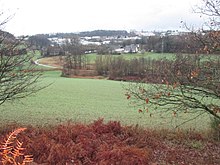Röbbeck (courtyard)
|
Röbbeck (homestead)
City of Velbert
Coordinates: 51 ° 21 ′ 18 ″ N , 7 ° 4 ′ 16 ″ E
|
||
|---|---|---|
| Height : | 170 m above sea level NHN | |
|
Location of Röbbeck (homestead) in Velbert |
||
|
The farm Röbbeck in the Valley of Röbbeck . The small stream in the foreground is the Peepes Beeke.
|
||
Röbbeck is a residential area in the northeast of the city of Velbert .
Location and description
The living space is at the northern foot of the Velberter Höhenrücken in the Röbbeck valley, which the Pepes Beeke receives here.
Due to the construction of the industrial area and the Plöger quarry dump, the farm, which was lonely until the 1970s, is now on the outskirts of the city. Nevertheless, in the Röbbeck valley there is still a very original cultural landscape with wet meadows and the remains of a silted-up mill pond.
Etymology and history
The Röbbeck farm in the former farming community of Rottberg was first mentioned in a document in 1050 under the name Rotbeki, from rod = clearing.
1491 is listed in the register of the Werden rent master Johann de Rude in the Rotbeck with 2 Malter oats .
Just around 1000 m below the source of the Röbbeck there was a grain mill in the heart of the Rottberg farmers .
On June 11, 1598, the underage "von Bernsau zu Hardenberg" (Bergische Unterherrschaft Hardenberg) , represented by their guardians, leased the "Mühle zu Rodtbeck" for life to Herman in der Rodtbeck (meaning Hof Röbbeck) and his wife Cecilie against an annual rent of 21/2 Malter rye and barley Hardenberger Maß, each to be paid with martini .
On October 25, 1606 , “the Rotberg Mill” was awarded to Philipp Wilhelm in an inheritance division between Philipp Wilhelm and Wirich von Bernsau and their sister Amöne Walpurg, who had already been resigned earlier.
In 1650 it is recorded as a mill at Rodtberg under the “Müllen Lachten ahns Hardenbergh”, according to which it has to deliver 3 Malter rye and barley, Hardenbergisches Maß, every year. For the surrender, Mr. von Hardenberg had made 7 farms subject to compulsory payment, i.e. the Rautenhaus Hof, Sondermanns Hof, Pipes Kotten, Vogelsangskotten, Schmittmanns Kotten, Winackers Kotten and the Röbbeck itself.
In 1811 the ban rights for waters that are not navigable or floodable were lifted. The owners of the Röbbeckhof then lead several lawsuits against the Hardenberg rule.
Finally, in 1910, the mill was "shut down and the grinding plant sold to the Zeche Zentrum near Bochum ".
According to the statistics and topography of the Düsseldorf administrative district from 1832, the residential area "In der Röbbeck" included 1 mill, 5 agricultural buildings and 3 residential houses in which 28 Protestant and 1 Catholic residents lived. In 1841 the population was 40.
literature
- Ludwig Bender: History of the former rule Hardenberg in the Bergisch region from prehistoric times to its abolition. Published by Julius Joost, Langenberg 1897.
Individual evidence
- ↑ StA Münster, Dep. Crassenstein, Archives Hardenberg files 498
- ^ City archive Velbert-Neviges 10.10
- ↑ Velberter Zeitung 18./19. May 1935
- ↑ Johann Georg von Viebahn : Statistics and Topography of the Administrative District of Düsseldorf , 1836


